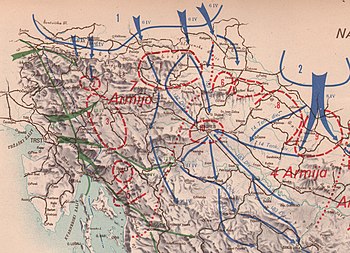The 1st Army was a Royal Yugoslav Army formation commanded by Armijski đeneral Milan Rađenković during the German-led Axis invasion of the Kingdom of Yugoslavia in April 1941 during World War II. It consisted of one infantry division, one horsed cavalry division, and two brigade-strength infantry detachments. It formed part of the 2nd Army Group, and was responsible for the defence of the section of the Yugoslav-Hungarian border between the Danube and the Tisza rivers.

The Croatian Home Guard was the land army part of the armed forces of the Independent State of Croatia which existed during World War II.

The invasion of Yugoslavia, also known as the April War or Operation 25, was a German-led attack on the Kingdom of Yugoslavia by the Axis powers which began on 6 April 1941 during World War II. The order for the invasion was put forward in "Führer Directive No. 25", which Adolf Hitler issued on 27 March 1941, following a Yugoslav coup d'état that overthrew the pro-Axis government.
The Russian Protective Corps was an armed force composed of anti-communist White Russian émigrés that was raised in the German occupied territory of Serbia during World War II. Commanded for almost its whole existence by Lieutenant General Boris Shteifon, it served primarily as a guard force for factories and mines between late 1941 and early 1944, initially as the "Separate Russian Corps" then Russian Factory Protective Group. It was incorporated into the Wehrmacht on 1 December 1942 and later clashed with the communist-led Yugoslav Partisans and briefly with the Chetniks. In late 1944, it fought against the Red Army during the Belgrade Offensive, later withdrawing to Bosnia and Slovenia as the German forces retreated from Yugoslavia and Greece. After Shteifon′s death in Zagreb, the Independent State of Croatia, on 30 April 1945, Russian Colonel Anatoly Rogozhin took over and led his troops farther north to surrender to the British in southern Austria. Unlike most other Russian formations that fought for Nazi Germany, Rogozhin and his men, who were not formally treated as Soviet citizens, were exempt from forced repatriation to the Soviet Union and were eventually set free and allowed to resettle in the West.
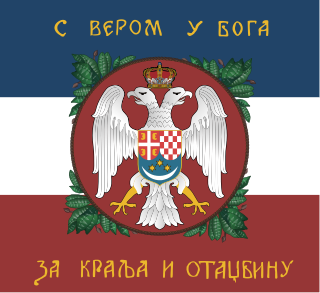
The Yugoslav Army, commonly the Royal Yugoslav Army, was the land warfare military service branch of the Kingdom of Yugoslavia. It existed from the Kingdom's formation in December 1918, until its surrender to the Axis powers on 17 April 1941. Aside from fighting along the Austrian border in 1919 and 1920 related to territorial disputes, and some border skirmishes on its southern borders in the 1920s, the JV was not involved in fighting until April 1941 when it was quickly overcome by the German-led invasion of Yugoslavia.
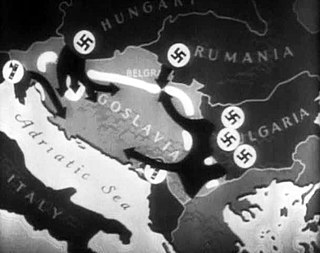
The Yugoslav order of battle before the invasion of Yugoslavia includes a listing of all operational formations of the Royal Yugoslav Army, Royal Yugoslav Army Air Force and Royal Yugoslav Navy immediately prior to the World War II invasion of that country in April 1941.
The 1st Army Group was a Royal Yugoslav Army formation mobilised prior to the German-led Axis invasion of Yugoslavia in April 1941 during World War II. It consisted of the 4th Army, 7th Army, and the 1st Cavalry Division, which was the army group reserve. It was responsible for the defence of northwestern Yugoslavia, with the 4th Army defending the eastern sector along the Yugoslav–Hungarian border, and the 7th Army defending the western sector along the borders with Germany and Italy. Like all Yugoslav formations at the time, the 1st Army Group had serious deficiencies in both mobility and firepower as well as internal friction among the different ethnic groups, particularly between Serbs and Croats.
The 2nd Army Group was a Royal Yugoslav Army formation commanded by Armijski đeneral Milutin Nedić during the German-led Axis invasion of the Kingdom of Yugoslavia in April 1941 during World War II. It consisted of the 1st and 2nd Armies, comprising four infantry divisions, one horsed cavalry division, two brigade-strength infantry detachments, and one horsed cavalry regiment. It was responsible for the defence of the border with Hungary from Slatina to the Tisza river.

The 2nd Army was a Royal Yugoslav Army formation commanded by Armijski đeneral Dragoslav Miljković that opposed the German-led Axis invasion of the Kingdom of Yugoslavia in April 1941 during World War II. It consisted of three infantry divisions and one horsed cavalry regiment along with supporting units. It formed part of the 2nd Army Group, and was responsible for the defence of the Yugoslav–Hungarian border along the Drava river from Slatina to the Danube.
The 3rd Army was a Royal Yugoslav Army formation commanded by Armijski đeneral Ilija Brašić during the German-led Axis invasion of the Kingdom of Yugoslavia in April 1941 during World War II. It consisted of two reinforced infantry divisions, two infantry divisions, and a brigade-strength horsed cavalry detachment. It formed part of the 3rd Army Group, and was responsible for the Yugoslav-Albania border between Lake Ohrid and Lake Skadar.

The 4th Army was a Royal Yugoslav Army formation mobilised prior to the German-led Axis invasion of the Kingdom of Yugoslavia during World War II. It was drawn from the peacetime 4th Army District. When mobilised, it consisted of three divisions, a brigade-strength detachment, one horse cavalry regiment and one independent infantry regiment. It formed part of the 1st Army Group, and was responsible for defending a large section of the Yugoslav–Hungarian border, being deployed behind the Drava river between Varaždin and Slatina. Like all Yugoslav formations at the time, the 4th Army had serious deficiencies in both mobility and firepower.
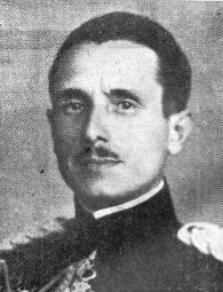
The 5th Army was a Royal Yugoslav Army formation which commanded five divisions and two independent detachments during the German-led Axis invasion of the Kingdom of Yugoslavia in April 1941 during World War II. It was commanded by General Vladimir Cukavac, and was responsible for the Romanian and Bulgarian borders between the Iron Gates and the Greek border.
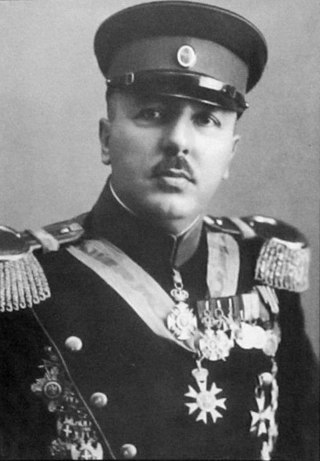
The 7th Army was a Royal Yugoslav Army formation raised prior to the German-led Axis invasion of Yugoslavia in April 1941, during World War II. It consisted of two divisions, two brigade-strength mountain detachments, and a brigade-strength infantry detachment. It formed part of the 1st Army Group, and was responsible for the defence of Yugoslavia's north-western frontier with Italy and Germany. Like all Yugoslav formations at the time, the 7th Army had serious deficiencies in both mobility and firepower.
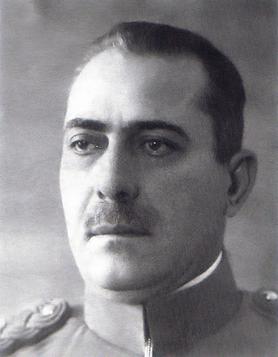
Milorad Petrović was an Armijski đeneral in the Royal Yugoslav Army who commanded the 1st Army Group during the April 1941 German-led Axis invasion of Yugoslavia of World War II. Petrović was commissioned into the Royal Serbian Army in 1901 and served in multiple staff positions during the Balkan Wars. During World War I, he served in various staff roles at the army and divisional level during the Serbian Campaign and later on the Macedonian front. Following the war, he took part in military operations along the disputed northern border of the nascent Kingdom of Serbs, Croats and Slovenes, which was renamed the Kingdom of Yugoslavia in 1929. During the interwar period, Petrović was steadily promoted, performing key roles at the Ministry of the Army and Navy. He reached the rank of armijski đeneral in 1937. At the time of the 27 March 1941 Yugoslav coup d'état, he was the military commander of the Yugoslav capital, Belgrade.
The 42nd Infantry Division Murska was an infantry formation of the Royal Yugoslav Army that formed part of the 4th Army during the German-led Axis invasion of the Kingdom of Yugoslavia in April 1941. It did not have a corresponding divisional district in peacetime, and was raised at the time of mobilisation. Like all Yugoslav infantry divisions of the time, it was a very large and unwieldy formation which was almost entirely reliant on animal transport for mobility, and also lacked modern arms and sufficient ammunition. Commanded by Divizijski đeneral Borisav Ristić, it was largely manned by Croat troops, many of whom saw the Germans as potential liberators from Serbian oppression.
The 40th Infantry Division Slavonska was an infantry formation of the Royal Yugoslav Army that formed part of the 4th Army during the German-led Axis invasion of the Kingdom of Yugoslavia in April 1941. It was partly mobilised from the Osječka military district, and, like all Yugoslav infantry divisions of the time, was a very large and unwieldy formation which was almost entirely reliant on animal transport for mobility. Commanded by Brigadni đeneral Ratko Raketić, it was largely manned by Croat troops, many of whom saw the Germans as potential liberators from Serbian oppression during the interwar period, and the division also lacked modern arms and sufficient ammunition.
The 27th Infantry Division Savska was an infantry formation of the Royal Yugoslav Army that formed part of the 4th Army during the German-led invasion of Yugoslavia by the Axis powers in April 1941. It was raised from the Savska divisional district, and like all Yugoslav infantry divisions of the time, was a very large and unwieldy formation almost entirely reliant on animal transport for mobility. Commanded by Divizijski đeneral August Marić, the division was largely made up of ethnic Croat troops, many of whom saw the Germans as potential liberators from Serbian oppression during the interwar period. It also lacked modern arms and sufficient ammunition.

The 32nd Infantry Division Triglavski was a short-lived Royal Yugoslav Army infantry formation raised prior to the German-led Axis invasion of the Kingdom of Yugoslavia in April 1941. It was largely mobilised from the Dravska military district, and, like all Yugoslav infantry divisions of the time, was a very large and unwieldy formation which was almost entirely reliant on animal transport for mobility. Commanded by Divizijski đeneral Dragiša Pandurović and largely manned by Slovene troops, the division also lacked modern arms and sufficient ammunition.
The 38th Infantry Division Dravska was a short-lived Royal Yugoslav Army infantry formation raised prior to the German-led Axis invasion of the Kingdom of Yugoslavia in April 1941. It was largely mobilised from the Dravska divisional district, and, like all Yugoslav infantry divisions of the time, was a very large and unwieldy formation which was almost entirely reliant on animal transport for mobility. Commanded by Divizijski đeneral Čedomir Stanojlović and largely manned by Slovene and ethnic German troops, the division also lacked modern arms and sufficient ammunition to meet the German onslaught.

Predrag Raković was a Yugoslav military officer who joined the Chetnik forces of Draža Mihailović after the Axis invasion of Yugoslavia in April 1941 during World War II. He became commander of the Chetnik 2nd Ravna Gora Corps and collaborated with the German-installed puppet government in the German-occupied territory of Serbia and later directly with the Germans against the rival communist-led Yugoslav Partisans. His forces briefly cooperated with Soviet forces against the Germans in October 1944, but faced with Soviet demands that they lay down their weapons or join the Partisans, they withdrew from occupied Serbia.
